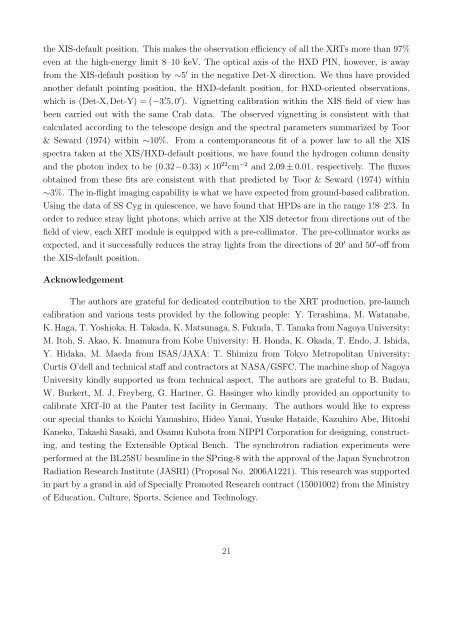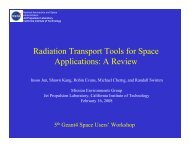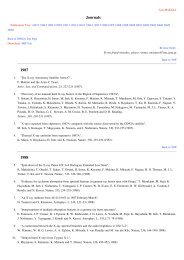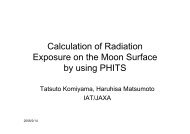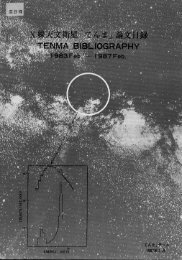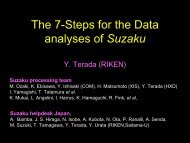2006-34: The X-ray Telescope onboard Suzaku - HEASARC - NASA
2006-34: The X-ray Telescope onboard Suzaku - HEASARC - NASA
2006-34: The X-ray Telescope onboard Suzaku - HEASARC - NASA
You also want an ePaper? Increase the reach of your titles
YUMPU automatically turns print PDFs into web optimized ePapers that Google loves.
the XIS-default position. This makes the observation efficiency of all the XRTs more than 97%even at the high-energy limit 8–10 keV. <strong>The</strong> optical axis of the HXD PIN, however, is awayfrom the XIS-default position by ∼5 ′ in the negative Det-X direction. We thus have providedanother default pointing position, the HXD-default position, for HXD-oriented observations,which is (Det-X, Det-Y) = (−3. ′ 5, 0 ′ ). Vignetting calibration within the XIS field of view hasbeen carried out with the same Crab data. <strong>The</strong> observed vignetting is consistent with thatcalculated according to the telescope design and the spectral parameters summarized by Toor& Seward (1974) within ∼10%. From a contemporaneous fit of a power law to all the XISspectra taken at the XIS/HXD-default positions, we have found the hydrogen column densityand the photon index to be (0.32−0.33) × 10 22 cm −2 and 2.09 ± 0.01, respectively. <strong>The</strong> fluxesobtained from these fits are consistent with that predicted by Toor & Seward (1974) within∼3%. <strong>The</strong> in-flight imaging capability is what we have expected from ground-based calibration.Using the data of SS Cyg in quiescence, we have found that HPDs are in the range 1. ′ 8–2. ′ 3. Inorder to reduce st<strong>ray</strong> light photons, which arrive at the XIS detector from directions out of thefield of view, each XRT module is equipped with a pre-collimator. <strong>The</strong> pre-collimator works asexpected, and it successfully reduces the st<strong>ray</strong> lights from the directions of 20 ′ and 50 ′ -off fromthe XIS-default position.Acknowledgement<strong>The</strong> authors are grateful for dedicated contribution to the XRT production, pre-launchcalibration and various tests provided by the following people: Y. Terashima, M. Watanabe,K. Haga, T. Yoshioka, H. Takada, K. Matsunaga, S. Fukuda, T. Tanaka from Nagoya University:M. Itoh, S. Akao, K. Imamura from Kobe University: H. Honda, K. Okada, T. Endo, J. Ishida,Y. Hidaka, M. Maeda from ISAS/JAXA: T. Shimizu from Tokyo Metropolitan University:Curtis O’dell and technical staff and contractors at <strong>NASA</strong>/GSFC. <strong>The</strong> machine shop of NagoyaUniversity kindly supported us from technical aspect. <strong>The</strong> authors are grateful to B. Budau,W. Burkert, M. J. Freyberg, G. Hartner, G. Hasinger who kindly provided an opportunity tocalibrate XRT-I0 at the Panter test facility in Germany. <strong>The</strong> authors would like to expressour special thanks to Koichi Yamashiro, Hideo Yanai, Yusuke Hataide, Kazuhiro Abe, HitoshiKaneko, Takashi Sasaki, and Osamu Kubota from NIPPI Corporation for designing, constructing,and testing the Extensible Optical Bench. <strong>The</strong> synchrotron radiation experiments wereperformed at the BL25SU beamline in the SPring-8 with the approval of the Japan SynchrotronRadiation Research Institute (JASRI) (Proposal No. <strong>2006</strong>A1221). This research was supportedin part by a grand in aid of Specially Promoted Research contract (15001002) from the Ministryof Education, Culture, Sports, Science and Technology.21


